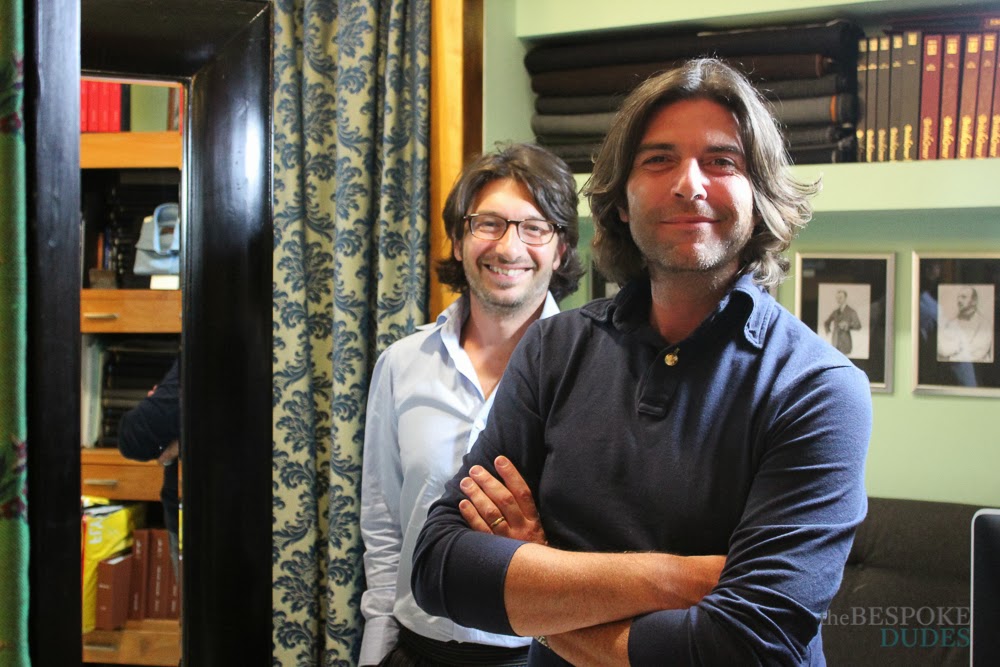Sciamátin Persian means “the king has died”, hence our “Checkmate”. Chackmate has got to do with fashion, but also with the old approach to the sartoria. According to this idea, it’s always the tailor to say the last word on the customer, who will have to adapt himself to the artisan’s vision of the suit, without a true level of customization, which indeed represents the true charm and the sense of the bespoke tailoring. At Sciamát they make a difference between the tailor and the sartoria, because the first is seen as a mere executor of the suit, whereas the second one is conceived as the place where the “male dream” comes true, the dream to dress like a true gentleman.
Sciamát in persiano vuol dire “il re è morto”, di qui il nostro “Scacco matto”. Scacco matto alla moda, ma anche alla vecchia concezione di sartoria. Secondo questo vetusto approccio, infatti, è sempre il sarto ad avere l’ultima parola sul committente, che dovrà adeguarsi alla visione dell’abito sposata dall’artigiano, senza un effettivo grado di personalizzazione, che, in fondo, rappresenta il fascino e il senso stesso del bespoke. Da Sciamát si fa una distinzione netta tra il sarto e la sartoria, identificando il primo in un mero esecutore materiale del capo e concependo la seconda come il luogo in cui si realizza il “sogno maschile”, cioè quello di vestirsi da “vero gentiluomo”.
Their story - La loro storia
Back in 2002, Valentino and Nicola Ricci founded Sciamát in their homeland Bitonto, in Apulia. Thet were moved by a deep passion for male elegance, but most of all by a tangible need: find an artisan making suits according to their personal taste. Valentino, civil lawyer yet bespoke enthusiast, was not a common customer: he was an active part of the sartoriaand wanted to attend to the cutting of his fabrics, yet sometimes fighting with the tailor, accustomed to work in a certain way andnot open to changes. It took ten years to communicate his vision to the tailor, the Master Filippo Tatulli, disciple of the renowned Master Trovato. Twelve years ago Tatulli was the first tailor willing to completely empy the suits for Valentino and Nicola and to make double-breasted blazers as light as shirts. After his passing, Valentino himself will commence to cut and create papermodels, before for his friends, after for the first customers.
Valentino e Nicola Ricci fondano Sciamát nel 2002 nella loro città, Bitonto. Erano spinti da una passione sfrenata per l’eleganza maschile in genere, ma soprattutto da un’esigenza concreta: trovare un artigiano che creasse abiti secondo il loro gusto personale. Valentino, avvocato civilista ma da sempre appasionato di sartoria, non era un cliente comune, era parte attiva della sartoria e voleva personalmente assistere al taglio dei tessuti dei suoi capi, pur scontrandosi spesso contro una mentalità chiusa dell’artigiano, abituato a lavorare in un determinato modo e non aperto al cambiamento. Ci metterà ben dieci anni per instradare il suo sarto, il Maestro Filippo Tatulli, discepolo del celebre Maestro Trovato. Il Tatulli è stato il primo sarto dei fratelli Ricci a mostrarsi disponibile a svuotare completamente gli abiti, a fare doppi petti leggeri come camicie, già dodici anni fa. Dopo la sua scomparsa, sarà lo stesso Valentino che inizierà a tagliare e creare cartamodelli, prima per gli amici, poi per i primi clienti.
Apart from the true Bespoke, Sciamát offers two RTW lines: Superior Collection: the pure bespoke applied to the prêt-à-porter. The product is completely hand-made, but it’s not made-to-measure. Peculiarity of this line are the papermodels, different for every Country in which the company sells, so that same sizes will have diverse dimensions depending on the Country. Sciamát Line: same models of the Superior, but less hand-made steps. Inner linings and pockets are sewn with a machine.
Oltre al Bespoke vero e proprio, Sciamát offre due linee di prêt-à-porter: La Superior Collection trasla la fase di produzione della sartoria pura sul pronto in taglia. Il prodotto è realizzato interamente a mano, ma non è su misura. Peculiarità di questa linea sono i cartamodelli personalizzati per ogni Paese in cui l’azienda vende, pertanto le medesime taglie avranno dimensioni diverse in base al Paese di riferimento. La Linea Sciamát ha la stessa modellistica della Superior, ma meno punti cuciti a mano. Fodere interne e tasche sono cucite a macchina.
What makes a Sciamát blazer so special, so that it gets approvals from every corner of the world? Here you have some peculiarities:
Despite no canvas on the inside, the blazer has character and “stands up”; Both tucks on the front stop at the pocket, so that the bottom is clean and the pattern is not interrupted; The pattern is not interrupted by the seam, also on the sleeve. The lower forearm is 7 cm longer than upper one. Very deep side vents in order to give height to the customer.
Cosa rende un blazer Sciamát tanto particolare, al punto da fargli ottenere consensi in tutto il mondo? Eccone alcune peculiarità:
pur senza canvas all’interno, la giacca ha carattere, “sta su”; entrambe le riprese sul davanti si fermano alla tasca, così da lasciare “pulito” il fondo della giacca, non rovinando l’eventuale pattern in caso di giacca con fantasia a quadri, questi coincidono anche nel sottobraccio, che è più lungo di 7 cm del sovrabraccio. Spacchi molto alti per verticalizzare la figura
Moreover Sciamát has registered three patents. The first is about the so called “90-degrees-wide Cran” (sgarzillo in Neapolitan dialect), that is the angle between the collar and the lapel, normally less wide than 90 degrees; the second is about the saber-shaped pocket and the third is the rounded hem of the sleeve. These peculiarities have contributed to make a Sciamát blazer recognisable in the world.
Sciamát, inoltre, ha registrato ben tre brevetti. Il primo riguarda il “cran a 90°”; per i non addetti ai lavori, il “cran” indica lo spazio tra il collo e il bavero (a Napoli ribattezzato “sgarzillo” ndr), che generalmente ha una forma detta “a bocca di pesce”; il secondo riguarda la tasca applicata “a sciabola” e il terzo la manica stondata. Particolari, questi, che hanno contribuito a rendere riconoscibile nel mondo una giacca Sciamát.
90°-wide Cran
Rounded hem of the sleevePatch PocketThe employees are approximately ten, in addition to an external shirt maker. “We started our business making blazers for friends and now we sell in Japan, Korea, Greece and Holland” – they tell me while I record details, colours and fabrics in their workshop in Bitonto, among unusual and amazing ensembles, where cotton ties perfectly match with Casentino coats and shirts with high one-button collars and no buttonholes on the cuffs. The worship for the beauty here is tangible and when I ask “how many hours of work for a suit?” I get a smile back. “You can’t state it previously – they explain – because it depends on many variables, like the number of employees working on the suit, but also on the amount of details requested by the customer: of course it takes more time to stitch an hand-made patch pocket on the shirt or to fell by hand the side of a blazer”.
I collaboratori interni sono circa dieci, oltre una camiciaia esterna. “Abbiamo iniziato facendo le giacche agli amici, adesso vendiamo in Giappone, Korea, Grecia e Olanda.” – mi dicono mentre registro particolari, colori e tessuti nel loro laboratorio e nel loro negozio di Bitonto, dove il bello è declinato in abbinamenti inusuali e fantastici al contempo, dove cravatte in manopesca si coordinano perfettamente con cappotti in casentino, camicie senza asole ai polsini e con colli alti ma ad un solo bottone. Il culto del bello qui è palese e alla domanda “quante ore di lavoro per un abito?” ottengo un sorriso di risposta. “Non si può stabilire a priori – mi spiegano – perché dipende da tante variabili, come il numero dei dipendenti che lavorano sull’abito, ma anche dai dettagli richiesti dal committente; una tasca applicata a mano su una camicia o un fianco ribattuto con ago e filo richiedono ovviamente più lavoro”.
If you like what we are doing here, please consider following TBD on Facebook - Tumblr - Instagram - Twitter
A Day with... Sciamát
10 October 2013







